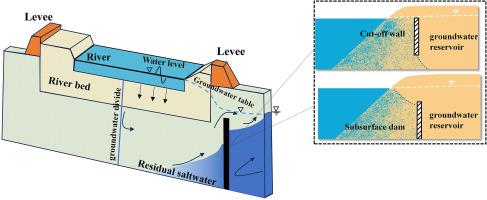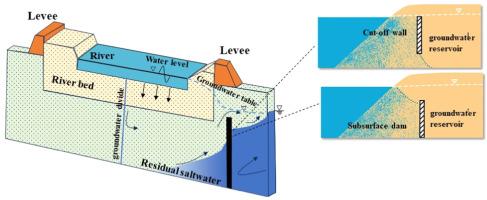Impact of river-groundwater interactions on residual saltwater pollution in estuarine groundwater reservoirs
IF 12.4
1区 环境科学与生态学
Q1 ENGINEERING, ENVIRONMENTAL
引用次数: 0
Abstract
The hydrodynamics of estuarine groundwater reservoirs is governed by both subsurface dams and river systems. However, existing research has largely overlooked how river-groundwater interactions influence groundwater discharge and residual saltwater desalination. This study combines field data from the Dagu River Basin with numerical simulations to explore how surface water-groundwater interactions promote residual saltwater desalination behind subsurface dams in coastal aquifers. The results indicate that continuous river-supplied freshwater creates a hydraulic barrier, limiting saltwater intrusion and enhancing freshwater infiltration. Following the construction of dam, Cl- flux at the ocean boundary stabilizes after approximately 20 years, reflecting a phased desalination process driven by hydraulic adjustments. Key factors such as riverbed sediment conductivity, sediment thickness, and dam height significantly enhance or diminish desalination efficiency. Higher riverbed hydraulic conductivity (e.g., 10 m/d) and thinner sediment layers (e.g., 5 m) accelerate freshwater penetration and salt discharge, achieving near-complete desalination within 20 years. Increasing dam height to 24–28 m raises the hydraulic gradient, enabling the total salt mass removal rate to reach 1 within 20–40 years, indicating complete desalination. Conversely, greater sediment thickness (e.g., 25 m) and low hydraulic conductivity (e.g., 0.5 m/d) slow the desalination process, extending the timeframe to nearly 100 years and increasing parameter sensitivity. Although dam height has a significant effect on desalination dynamics, the distance from the ocean has minimal influence once an effective hydraulic barrier is established. These findings emphasize optimizing dam height and sediment properties to improve desalination efficiency, offering guidance for groundwater management in saltwater-affected regions.


河流-地下水相互作用对河口地下水库剩余盐水污染的影响
河口地下水库的水动力受地下坝和河流水系共同控制。然而,现有的研究在很大程度上忽视了河流-地下水相互作用对地下水排放和剩余盐水淡化的影响。本研究结合大沽河流域的野外数据和数值模拟,探讨了地表水-地下水相互作用如何促进沿海含水层地下大坝后剩余盐水的淡化。结果表明,连续的河流供水形成了一个水力屏障,限制了咸水的入侵,增强了淡水的入渗。在大坝建设之后,海洋边界的Cl-通量在大约20年后趋于稳定,反映了水力调节驱动的分阶段脱盐过程。河床底泥电导率、底泥厚度、大坝高度等关键因素对海水淡化效率有显著的提高或降低作用。更高的河床水力传导性(如10米/天)和更薄的沉积层(如5米)加速了淡水渗透和盐排放,在20年内实现了近乎完全的海水淡化。将坝高增加到24-28 m,使水力梯度增大,使总盐质量去除率在20-40年内达到1,表明海水淡化完全。相反,较大的沉积物厚度(例如25 m)和较低的水力导电性(例如0.5 m/d)减慢了海水淡化过程,将时间范围延长至近100年,并增加了参数敏感性。虽然大坝高度对海水淡化动力学有显著影响,但一旦建立了有效的水力屏障,与海洋的距离的影响就微乎其微。这些发现强调优化大坝高度和沉积物特性以提高海水淡化效率,为受盐水影响地区的地下水管理提供指导。
本文章由计算机程序翻译,如有差异,请以英文原文为准。
求助全文
约1分钟内获得全文
求助全文
来源期刊

Water Research
环境科学-工程:环境
CiteScore
20.80
自引率
9.40%
发文量
1307
审稿时长
38 days
期刊介绍:
Water Research, along with its open access companion journal Water Research X, serves as a platform for publishing original research papers covering various aspects of the science and technology related to the anthropogenic water cycle, water quality, and its management worldwide. The audience targeted by the journal comprises biologists, chemical engineers, chemists, civil engineers, environmental engineers, limnologists, and microbiologists. The scope of the journal include:
•Treatment processes for water and wastewaters (municipal, agricultural, industrial, and on-site treatment), including resource recovery and residuals management;
•Urban hydrology including sewer systems, stormwater management, and green infrastructure;
•Drinking water treatment and distribution;
•Potable and non-potable water reuse;
•Sanitation, public health, and risk assessment;
•Anaerobic digestion, solid and hazardous waste management, including source characterization and the effects and control of leachates and gaseous emissions;
•Contaminants (chemical, microbial, anthropogenic particles such as nanoparticles or microplastics) and related water quality sensing, monitoring, fate, and assessment;
•Anthropogenic impacts on inland, tidal, coastal and urban waters, focusing on surface and ground waters, and point and non-point sources of pollution;
•Environmental restoration, linked to surface water, groundwater and groundwater remediation;
•Analysis of the interfaces between sediments and water, and between water and atmosphere, focusing specifically on anthropogenic impacts;
•Mathematical modelling, systems analysis, machine learning, and beneficial use of big data related to the anthropogenic water cycle;
•Socio-economic, policy, and regulations studies.
 求助内容:
求助内容: 应助结果提醒方式:
应助结果提醒方式:


